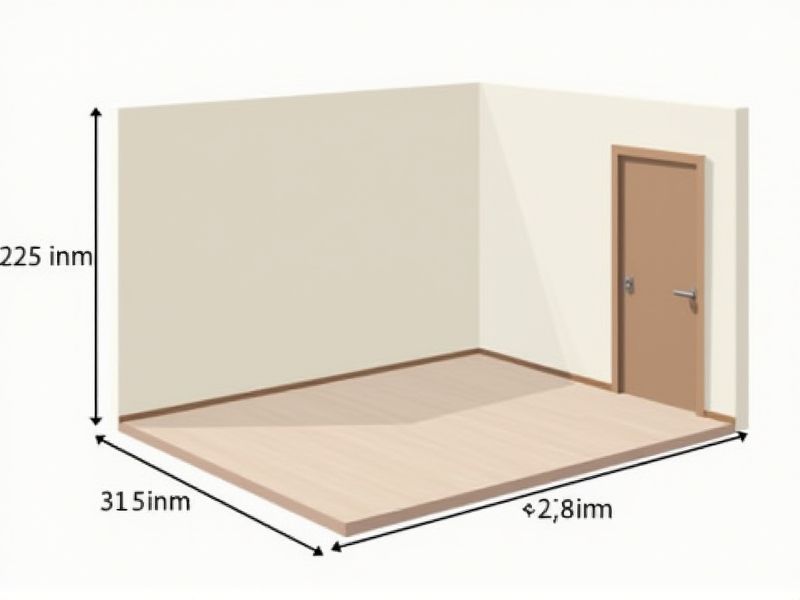
The standard dimensions of a single room can vary based on location and building codes, but most commonly, a single room measures around 9 feet by 12 feet (approximately 2.7 meters by 3.7 meters). This size is generally sufficient to fit a single bed, a small desk, and storage space, providing comfort and functionality for one person. When planning or renovating, consider the room's intended use and ensure there is enough natural light and ventilation. Checking local standards or architectural guidelines will help you tailor the dimensions to suit your needs and maximize usability.
Minimum Area Size
The standard minimum area size for a single room typically ranges from 70 to 100 square feet, ensuring adequate space for essential furnishings and movement. This space allocation often includes necessary amenities such as a bed, desk, and wardrobe. Compliance with local building regulations may require additional considerations like ceiling height, natural light access, and ventilation. Utilizing effective space management techniques can significantly enhance the livability of these compact environments.
Ceiling Height
The standard ceiling height for a single room typically ranges from 2.4 meters (7.9 feet) to 2.7 meters (8.9 feet) in residential buildings, allowing for adequate airflow and a comfortable sense of space. Higher ceilings, around 3 meters (9.8 feet), can enhance natural light and create a more open atmosphere, which is especially beneficial in smaller rooms. Building codes in many regions mandate these minimum heights to ensure safety and livability, impacting your choice of design and layout. Consideration of your room's ceiling height can significantly influence furniture selection and overall aesthetics.
Door Dimensions
The standard dimensions for a single room door typically measure 32 inches in width and 80 inches in height, ensuring accessibility and ease of use. For optimal functionality, the door should be constructed with sturdy materials, such as solid wood or steel, to enhance security and durability. A standard door thickness ranges from 1.75 inches, which provides sufficient insulation and soundproofing. You may consider including proper hardware like heavy-duty hinges and a quality locking mechanism to further enhance the door's reliability and performance.
Window Size
In a standard single room, the window size typically measures at least 2 feet by 3 feet to ensure adequate natural light and ventilation. This dimension not only contributes to the overall ambiance but also supports energy efficiency by reducing reliance on artificial lighting during the day. Rooms with larger windows, averaging 3 feet by 5 feet, can enhance the feeling of openness, creating a more inviting space. When selecting accommodations, consider how the size of the window impacts your comfort and the room's overall aesthetic.
Wall Thickness
The standard wall thickness for a single room typically ranges from 4 to 6 inches, ensuring adequate insulation and soundproofing. This thickness is essential for maintaining structural integrity while accommodating plumbing and electrical installations. In many regions, local building codes may dictate specific requirements, which often include fire safety regulations. When designing your single room, consider how these factors impact heating and cooling efficiency, as well as overall comfort.
Floor-To-Ceiling Ratio
The floor-to-ceiling ratio in a standard single room significantly influences its perceived spaciousness and natural light intake. A recommended ratio of 1:1.5 between the floor area (in square meters) and the height of the ceiling (in meters) optimizes comfort and aesthetics. For instance, in a 25 square meter room, a ceiling height of approximately 3.5 meters enhances openness and airflow. Evaluating this ratio can help you create a more inviting and functional living space.
Standard Furniture Layout
The standard single room typically features a well-organized furniture layout that maximizes space efficiency, usually measuring around 100 to 150 square feet. Common elements include a twin or full-size bed, a bedside table, and a desk with a chair, ensuring essential functionality for various activities. You can expect ample storage options, including a wardrobe or dresser, allowing for organized accommodation of your belongings. The room's design often utilizes neutral color palettes and optimal lighting to create a comfortable and inviting atmosphere.
Electrical Outlet Placement
In a standard single room, optimal electrical outlet placement is crucial for maximizing functionality and convenience. Ideally, outlets should be positioned at least 12 inches above the floor to accommodate various devices, with a recommended quantity of 2 to 4 outlets per wall. Incorporating USB charging ports can further enhance usability, allowing you to easily charge multiple devices without the need for adapters. Consider placing outlets near key areas such as the bedside, desk, and entertainment space to ensure efficient access to power wherever needed.
Lighting Fixture Locations
In a standard single room, optimal lighting fixture placement is crucial for both functionality and ambiance. Typically, ceiling-mounted fixtures should be positioned at a height of 8 to 10 feet, while table lamps are ideally located on side tables, about 28 to 32 inches above the floor. Consider incorporating task lighting in areas like desks, with fixtures providing at least 100 lumens per square meter for effective work environments. To enhance mood, accent lighting can be strategically placed to highlight artwork or architectural features, creating a balanced and inviting atmosphere.
Ventilation Requirements
The standard ventilation requirement for a single room is a minimum of 15 cubic feet per minute (CFM) per occupant, ensuring adequate air quality and comfort. This translates to an air change rate of at least 0.35 air changes per hour to maintain a healthy indoor environment. If your single room measures 100 square feet, it requires at least 400 CFM to effectively circulate fresh air. Compliance with these standards not only improves thermal comfort but also reduces the risk of airborne contaminants.
